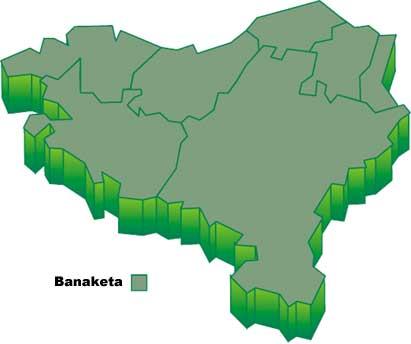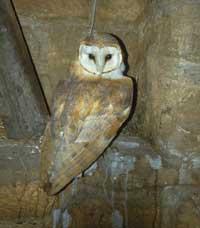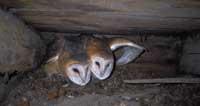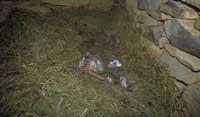Owl, a wise family planner

20 minutes ago the sun hides between the western summits and says it until tomorrow. In the sky a lot of stars have been lit and the moon can also sense that it will soon appear. A slender white bird came out of the church tower and after two or three laps, it was thrown into the adjoining field. It has settled very erneamente in the port, waiting and between the worms a soft "krax" has been heard and has flew quixoso but straight towards there.
When he saw the sataina, his legs stretched forward and fell on him, putting sharp barks like swords into the flesh. The carrasquito has not had a half cry. The sattaina has returned to the church with a little charm, our white hunter, to which they have welcomed some rare songs just appear in the window.

The fact of appearing throughout the Basque Country and living around the human being has made the white owl ( tyto alba) well known. Life in the churches, night and this song as special as snoring have given rise to beliefs and legends around this bird.
It is a fungus of medium size, with a length of 33-39 cm and an average weight of 350 grams. However, the flight width is 90-95 cm, which is high. This owl is one of those that has no “ear” and on the round head stand out two large black eyes on the white face with a heart shape. The hunting utensils are a pointed whitish beak shaped as a key and armed claws with eight black barks. To capture hunting pieces at night use incredible vision and hearing.
The forward-facing eyes give you a wide binocular (three-dimensional) vision, and the pavilion shape of the face helps to perceive sounds like the ears. As for the coloring, at first glance you can see the clear clothing. The lower parts are generally white, but they are also cream and specimens decorated with small black pints. The upper part, on the other hand, is sandy, yellowish or orange, interspersed with silver and gray. The long legs are decorated with white feathers up to the fingers.
This bird appears in open rustic lands, in the surroundings of the villages and hamlets, and in general in the places that offer laundries for hunting. This is why in the Roncal area and similar forest-covered regions there is very low density. To sleep he likes the church, the embroider, the old trees and the rocky cliffs. One of the easiest ways to detect is to detect the egagrópilas that pulls.
These are long balls formed by bones, feathers, other hard parts of prey and hairs expelled from the mouth by the difficulty of digestion and without passing through the intestine. In the case of the White Owl they have a diameter of 2,5-3,5 cm and their exterior is grey-brown dark and very soft.

The study of these egagrópilas can also reveal the power of this nocturnal hunter. Micromammals are the most consumed game (90% of the diet) and much less small birds, amphibians and insects (10%). It is a fungus perfectly adaptable to different situations, which can sometimes specialize in hunting sparrows and starlings in frequented areas.
The gestation period usually lasts between March and July. Without nesting, you will place between 4 and 7 white eggs in a dark place in the church or loft. These relatively rounded eggs of 40 x 31 mm put them at approximate intervals of two days. Although the female is in charge of incubation, the male will have to earn food.
Since the female started incubating since she put the first egg, the first puppy will be two days older than the next and will take four to the third. The last brother may be two weeks younger. Therefore, the first chickens born are more likely to get ahead and mortality will be much higher in the smaller ones. This system, although it may seem otherwise, is suitable for pulling the largest number of offspring forward. Thus, in the year in which food is very abundant, the owl can grow all chickens. However, if you do not get enough food, the first born will have much more chances to get ahead, since the youngest will not be able to even half a snack, as they will die in chain.

In addition to this curious system, even before the laying of eggs begins, the white owl, depending on its abundance of prey, has the ability to calculate how many eggs it will lay, and when the scarcity of hunting is high, may not attempt to reproduce, avoiding all unnecessary energy expenses. Also, if the populations of rodents are very high, the population of owl will also increase twice.
In any case, these eggs need a coat of 30 to 34 days and another 50-60 days for the offspring to nest. Highlights the bustle found in the nest of white owl. The little ones, always hungry, sound full and for those who do not know this song as special as the deep inspiration, it can be surprising (and even terrifying for some). If we approach the nest, mom and baby, all rise up, moving their heads everywhere, making “shh”, clearly indicating that the visitor is not welcome.
This hunter can appear throughout our territory, except in very industrialized or very wooded areas. In Europe it is also widespread, only missing in Scandinavia and the Baltic countries. It seems, therefore, that it is missing in those regions where winter can be too hard, and here too has been observed a high mortality of white owls in the years of the great snowfall.
This ecclesiastical bird is a tireless worker, especially controlling the population of micromammals, and it is estimated that a couple growing the kid can capture 50 mice in a single night. However, the demolition of old buildings, the theft of chickens, the shooting, the mortality on the roads and many other problems must be solved so that the intelligent family planner continues to live in all our villages.
Species: Tyto alba |





